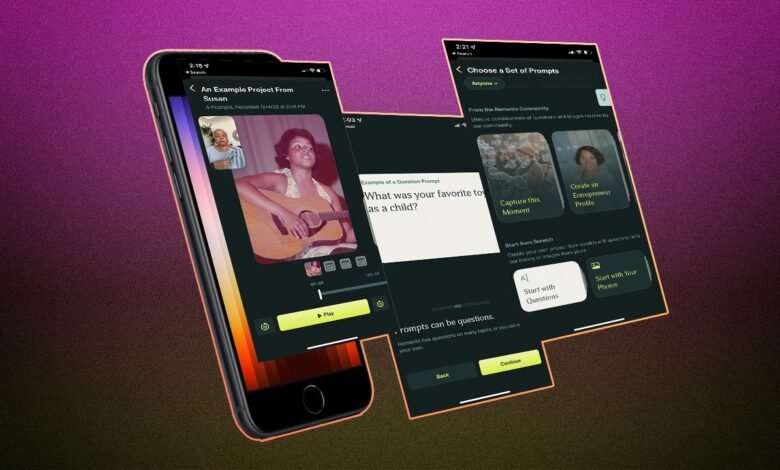
This App Help Preserve Your Family History.In order to preserve institutional memory and retain important lessons, senior leaders are frequently interviewed in organisations before they retire. Similar to this, kids and grandkids frequently make vain attempts to persuade their loved ones to fill in the blanks in their life before it’s too late to ask.
There are several ways to go about doing this, such as opening the camera on your phone and pressing record or giving grandma a pen and paper, but a number of services have appeared in recent years to assist people in asking their loved ones the right questions and, hopefully, to spark conversations about memories that would otherwise be lost to time.
Remento is one such service (Opens in a new window). With $3 million in investment, it debuted in September on iOS (android will follow soon) (Opens in a new window). The purpose of it is to make it simple to record, save, and share family stories. I pulled out my old iPod touch from my electronics graveyard and launched Remento as an Android user to take a look back in time. It provided a unique opportunity to record significant life events as well as more esoteric thoughts, but the UI could use some work, and the app should use a virtual host to encourage camera-shy users to be a little more open. Here is what to anticipate.
My Name Is Not Susan
Remento presents an example project called “Susan” on the My Projects screen after giving a brief run-through of its capabilities. It displays a picture of an elderly woman (I assume Susan) next to a sepia-toned image of her from many years ago on the right, playing an acoustic guitar.

I selected Susan’s avatar and then hit the play button at the bottom of the display. Susan provides background information on the picture in a thumbnail film that is inserted into the older snapshot. Three text squares with Susan’s responses to the questions (“How did that experience make you feel?” “What made this so memorable?” and “What might have made this experience even more memorable?”) are located beneath the photograph.
After listening to Susan’s tale for four minutes, I went back to the home screen, hit the three dots, and then chose Delete Project. It was time for me to go on my own nostalgic journey.
Who Tells Your Story?
Tap the plus (+) sign button in the bottom right corner to begin. Choose from a list of questions for yourself or the person you’ll be interviewing (you, your parent(s), grandparent(s), sibling(s), partner(s), child(ren), or anybody else) on the next screen. Alternatively, scroll to the bottom and start from scratch with questions or photos.

I have a respected professional mentor who is now in their 80s and is full of fascinating experiences. But when I questioned them, they gave me a frightened expression as though I had said, “You might die any day now, could we record some of your stories?” (I didn’t, at least not in public.)
And that’s kind of the issue with these apps. In essence, you’re inviting a close friend or relative to share their life narrative with you while also acknowledging their coming death. Unsurprisingly, all of us are a little sensitive about that topic now that COVID has happened.
Having given up on finding an interviewee, I decided not to select the “Myself” option because it felt strange. I chose “Anyone” in order to see what the conversational prompts would be.
Setting Up the Interview
I was given ten different sets of interview questions when I choose “Anyone” as the subject of the interview, including “Record the Story Behind an Object,” “Reflect on Scrapbook Photos,” and “Capture this Moment.” There were sets with only one question or prompt and others with five or six.

I had the option to select or deselect six potential prompts on the following screen. The procedure is not quite obvious. The first prompt, which is an empty photo square above the question “What is this object?You then select Use X of 6 Prompts to go to a screen where you may select the photo icon to upload an existing photo or snap a new one. However, I found it to be a little picky and it wouldn’t accept the picture I’d chosen.
Instead, I looked over a few of the other prompt choices. I opened the three-dot menu inside the project and chose Edit Prompts > Add Prompts > Questions from Library. This displayed 12 categories divided into life stages (such as childhood, adolescence, love, parenting, and profession) or significant global events, such as COVID-19.

The “Career” queries (such as “What are the most significant lessons you’ve gained from your career?”) reminded me of standard job interview questions. While “Celebrations” detoured into therapy-level probing (“Are there family customs that you do not like?”), and the standard “What advise would you give your younger self?” question was included in “Self-reflection.”
Nothing really caught my attention, so I chose “Where in the world are you most at peace Additionally, I had the choice to include a query below the picture.
Record the Story Behind an Object
In order to record videos, the iOS permissions dialogue box will ask for access to your microphone and camera. Use the rear-facing camera to conduct interviews with friends or family members or take a selfie to record your own recollections.
I feel like I kind of got lost here. The questions about the object in my supplied photo have previously been answered, despite the appearance that it had disappeared. The question I had typed in under the image as prompt number seven led me to subsequently uncover the tape, even though the entire thing was supposed to be about this object. It must be there for the entire interview process, right? The last prompt was the one I had previously chosen, “Where in the world are you most at peace?”

READ MORE: Apple iOS 17 Leak: New Information: USB-C Dependence?
Playback and Export

I decided on the last one.
The combined 35.6MB file it extracted was too large to transmit via Gmail, so I saved it locally on my iPod touch and it showed up in my Albums where it played without any issues. I would have needed to upload it to the cloud and obtain a shareable link if I had wanted to distribute it.
Why Not Incorporate AI?
Remento still has a ways to go. The prompts’ idea is fantastic, and it’s clear that some thinking went into making them. After a few hiccups, I can see how one can conduct a respectable interview with a dear relative. However, the video embed is only a thumbnail size and is too small.
If you plan to use this, I suggest watching a few of Remento’s promotional videos(Opens in a new window) on Vimeo to get a sense of how the software works as it isn’t particularly obvious. If you want to see what other creators on TikTok have to say, click here to open a new window.
Not to sound depressing, but not every family has wonderful memories. However, challenging circumstances, difficulties, sufferings, and the like are fascinating and should be documented for history. It’s not always possible to persuade grandparents to open up to their grandchildren, and I can say this from personal experience.
For instance, I attempted to talk to several of my (now deceased) family members about their WWII daring-do escapades.
READ MORE: How to Automatically Remove Google Activity and Location History in 2023
AI, more precisely virtual humans, could be of assistance in this situation. I discovered how military veterans felt better at ease discussing their combat experiences with an AI that wouldn’t condemn them when I wrote about virtual humans that helped veterans prepare for job interviews.
I believe a future version of an app similar to Remento with a virtual interviewee who extracts memories from the subject would work very well. especially if the AI gradually earns the person’s trust by urging them to record a little bit every day.
The underlying NLP and machine learning may then derive semantic meaning, apply tags, categorise, populate metadata fields in the background, and present a coherent story.
Nowadays, many people have scattered social media profiles with at least ten years’ worth of recollections.There must be a way to deploy an AI in the background to continuously compile the high points of a person’s life and gradually construct the narrative, though.











